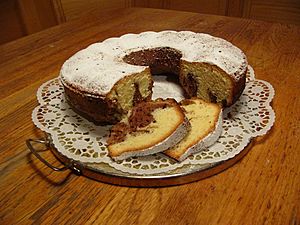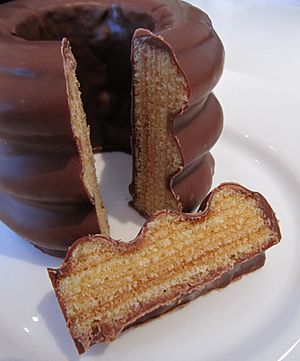Kuchen facts for kids

|
|
| Type | Desserts and pastries |
|---|---|
| Place of origin | Germany |
Kuchen is a German word that means "cake". It's also used in other languages to describe different kinds of sweet or savory treats, like pastries and desserts. Most Kuchen are made with common ingredients like eggs, flour, and sugar. Sometimes they also include fat.
In Germany, it's a popular tradition to invite friends over for "Kaffee und Kuchen" (coffee and cake). This usually happens between noon and evening.
The word "Kuchen" can describe many different desserts, just like the English word "cake." However, in German, there's a difference between "Kuchen" and "Torte". A Torte is a type of Kuchen that is decorated or has layers of cream, frosting, or fruit filling after it's baked. A Kuchen is usually simpler and less fancy. The word "Kuchen" can also refer to desserts that English speakers might call "pie," like Apfelkuchen (apple pie).
Contents
Types of Kuchen
There are many different kinds of Kuchen. Here are some popular types:
Pie-like Kuchen
This type of Kuchen looks a bit like a pie. It has a thick, cake-like crust and a sweet topping, often made with custard or chopped fruit. This is known as an Obstkuchen (fruit cake). Sometimes, it has sweet icing or decorative cream on top. Examples include Erdbeerkuchen (strawberry cake) and Apfelkuchen (apple cake).
Rolled Kuchen
A Kuchenrolle is a rolled pastry. It has a long spiral of dough, sometimes filled with cream or jam. It's baked and then sliced to serve. If nuts are added, it's sometimes called a nut roll.
Coffee Cake Style Kuchen
This Kuchen is similar to a coffee cake. It has swirls and pockets of cinnamon baked throughout. Its main ingredients are butter and sugar. A marble cake (Marmorkuchen) or a pound cake (Rührkuchen) are examples of this style. Streuselkuchen (crumb cake) is another variation.
Cheesecake Style Kuchen
This type is called Käsekuchen, which means "cheese cake". It often has a yeast-raised crust and a creamy filling. The filling is made from a German cheese called Quark. Sometimes, fruit like cherries are added to the filling.
Pan-Fried Kuchen
Pfannkuchen are German pancakes. They are thicker than French crepes and are often filled with sweet or savory ingredients. An egg-based version is called Eierkuchen.
Layered Kuchen
A Baumkuchen is a special layered pastry. It's made by brushing thin layers of batter onto a spit (a rotating rod) and baking each layer. This creates many rings, making it look like a tree trunk when sliced.
Sheet Pan Kuchen
Blechkuchen means "sheet cake". These Kuchen are baked on a flat baking sheet. They can be butter-based, like Butterkuchen, or filled with fruit. Lebkuchen is a type of Blechkuchen often made during Christmas.
Savory Kuchen
Not all Kuchen are sweet! There are also savory versions called Pikante Kuchen. Examples include Zwiebelkuchen (onion cake), Speckkuchen (bacon cake), and Kartoffelkuchen (potato cake). These are often enjoyed with fresh wine or beer.
Kuchen in Jewish Traditions
When Jewish immigrants first came to the United States, many of their recipes used dried fruits because fresh ones were hard to find. One popular dish was compote. Over time, desserts became more complex as fresh fruits became easy to get.
Lekach is a Jewish honey cake that comes from Germany. It's related to Lebkuchen, which is a honey-sweetened gingerbread. This tradition goes back to the 12th century. Back then, boys attending heder (a school for Jewish children) would bring a piece of honey cake on their first day.
Rugelach is a type of rolled pastry, similar to a Kuchenrolle. They are usually filled with nuts and raisins. The pastry dough is often made with cheese curds and sour cream.
Mandelbrot means "almond bread." It looks like bread and is served toasted, even though it's not made from bread dough. It's often eaten with sweet wine. Compared to Biscotti, Mandelbrot is usually softer and more cake-like.
Cultural Influence of Kuchen
Kuchen recipes have been passed down through generations, especially by people of German heritage. Because of this, Kuchen is popular in many parts of the United States where Germans settled. These areas include Montana, North Dakota, South Dakota, Indiana, Minnesota, and Wisconsin.
Kuchen was also brought to Chilean cuisine by German immigrants who settled in southern Chile in the 1850s. In Chile, Kuchen often have fruits like apples, strawberries, or murtas (Chilean guava). You can find Kuchen in many Chilean bakeries and larger supermarkets today.
In Brazil, Kuchen is called "cuca" or sometimes "cuque." It's found in areas with German settlements, such as the states of Rio Grande do Sul, Paraná, and Santa Catarina.
The French dish quiche was influenced by the savory versions of German Kuchen. It is now a well-known traditional French food.
In 2000, Kuchen was named the official state dessert of South Dakota. German settlers introduced Kuchen to the state in the 1870s. Today, you can find Kuchen throughout South Dakota in flavors like peach, apple, prune, and chocolate pecan.
See also
 In Spanish: Kuchen para niños
In Spanish: Kuchen para niños


